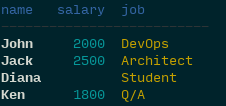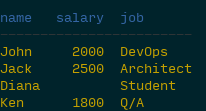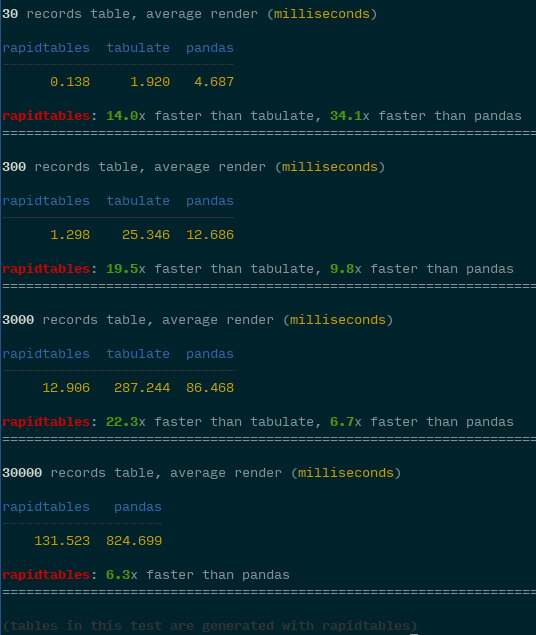Ecosyste.ms: Awesome
An open API service indexing awesome lists of open source software.
https://github.com/alttch/rapidtables
Super fast list of dicts to pre-formatted tables conversion library for Python 2/3
https://github.com/alttch/rapidtables
data-processing dictionary-data library python python3 text-formatting
Last synced: 6 days ago
JSON representation
Super fast list of dicts to pre-formatted tables conversion library for Python 2/3
- Host: GitHub
- URL: https://github.com/alttch/rapidtables
- Owner: alttch
- License: mit
- Created: 2019-08-24T23:23:32.000Z (over 5 years ago)
- Default Branch: master
- Last Pushed: 2019-11-17T00:35:39.000Z (about 5 years ago)
- Last Synced: 2024-10-29T21:12:18.926Z (3 months ago)
- Topics: data-processing, dictionary-data, library, python, python3, text-formatting
- Language: Python
- Homepage:
- Size: 254 KB
- Stars: 287
- Watchers: 12
- Forks: 10
- Open Issues: 0
-
Metadata Files:
- Readme: README.md
- License: LICENSE
Awesome Lists containing this project
README
# rapidtables
**rapidtables** is a module for Python 2/3, which does only one thing: converts
lists of dictionaries to pre-formatted tables. And it does the job as fast as
possible.



**rapidtables** is focused on speed and is useful for applications which
dynamically refresh data in console. The module code is heavily optimized and
written purely in Python.
And unlike other similar modules, **rapidtables** can output pre-formatted
generators of strings or even generators of tuples of strings, which allows you
to colorize every single column.
## Install
```shell
pip install rapidtables
```
## Example
```python
# if you need to keep strict column ordering, use OrderedDict for the rows
data = [
{ 'name': 'John', 'salary': 2000, 'job': 'DevOps' },
{ 'name': 'Jack', 'salary': 2500, 'job': 'Architect' },
{ 'name': 'Diana', 'salary': None, 'job': 'Student' },
{ 'name': 'Ken', 'salary': 1800, 'job': 'Q/A' }
]
from rapidtables import format_table, FORMAT_GENERATOR_COLS
from termcolor import colored
header, rows = format_table(data, fmt=FORMAT_GENERATOR_COLS)
spacer = ' '
print(colored(spacer.join(header), color='blue'))
print(colored('-' * sum([(len(x) + 2) for x in header]), color='grey'))
for r in rows:
print(colored(r[0], color='white', attrs=['bold']) + spacer, end='')
print(colored(r[1], color='cyan') + spacer, end='')
print(colored(r[2], color='yellow'))
```

Pretty cool, isn't it? Actually, it was the most complex example, you can
work with header + table rows already joined:
```python
from rapidtables import format_table, FORMAT_GENERATOR
header, rows = format_table(data, fmt=FORMAT_GENERATOR)
print(colored(header, color='blue'))
print(colored('-' * len(header), color='grey'))
for r in rows:
print(colored(r, color='yellow'))
```

Or you can use *make_table* function to return the table out-of-the-box (or
*print_table* to instantly print it), and print it in raw:
```python
print_table(data)
```
```
name salary job
---- ------ ---------
John 2000 DevOps
Jack 2500 Architect
Ken 1800 Q/A
```
## Quick API reference
### format_table
Formats a table. Outputs data in raw, generator of strings (one string per row)
or generator of tuples of strings (one tuple per row, one string per column):
* **fmt=rapidtables.FORMAT_RAW** raw string
* **fmt=rapidtables.FORMAT_GENERATOR** generator of strings
* **fmt=rapidtables.FORMAT_GENERATOR_COLS** generator of tuples of strings
Align columns:
* **align=rapidtables.ALIGN_LEFT** align all columns to left
* **align=rapidtables.ALIGN_NUMBERS_RIGHT** align numbers to right (default)
* **align=rapidtables.ALIGN_RIGHT** align all columns to right
* **align=rapidtables.ALIGN_CENTER** align all columns to center
* **align=rapidtables.ALIGN_HOMOGENEOUS_NUMBERS_RIGHT** align numbers to right
but consider the table is homogeneous and check col values only to first
number or string (works slightly faster)
To predefine aligns, set align to tuple or list:
align=(rapidtables.ALIGN_LEFT, rapidtables.ALIGN_RIGHT, ....)
number of items in list must match number of columns in table.
You may also customize headers, separators etc. Read pydoc for more
info.
### make_table
Generates a ready to output table. Supports basic formats:
```python
table = rapidtables.make_table(data, tablefmt='raw')
```
```
name salary job
-----------------------
John 2000 DevOps
Jack 2500 Architect
Diana Student
Ken 1800 Q/A
```
```python
table = rapidtables.make_table(data, tablefmt='simple')
```
```
name salary job
---- ------ ---------
John 2000 DevOps
Jack 2500 Architect
Diana Student
Ken 1800 Q/A
```
```python
table = rapidtables.make_table(data, tablefmt='md') # Markdown
```
```
| name | salary | job |
|-------|--------|-----------|
| John | 2000 | DevOps |
| Jack | 2500 | Architect |
| Diana | | Student |
| Ken | 1800 | Q/A |
```
```python
table = rapidtables.make_table(data, tablefmt='rst') # reStructured, simple
```
```
===== ====== =========
name salary job
===== ====== =========
John 2000 DevOps
Jack 2500 Architect
Diana Student
Ken 1800 Q/A
===== ====== =========
```
```python
table = rapidtables.make_table(data, tablefmt='rstgrid') # reStructured, grid
```
```
+-------+--------+-----------+
| name | salary | job |
+=======+========+===========+
| John | 2000 | DevOps |
+-------+--------+-----------+
| Jack | 2500 | Architect |
+-------+--------+-----------+
| Diana | | Student |
+-------+--------+-----------+
| Ken | 1800 | Q/A |
+-------+--------+-----------+
```
### print_table
The same as *make_table*, but prints table to stdout.
## Benchmarks
(Python 3.7)

Enjoy!